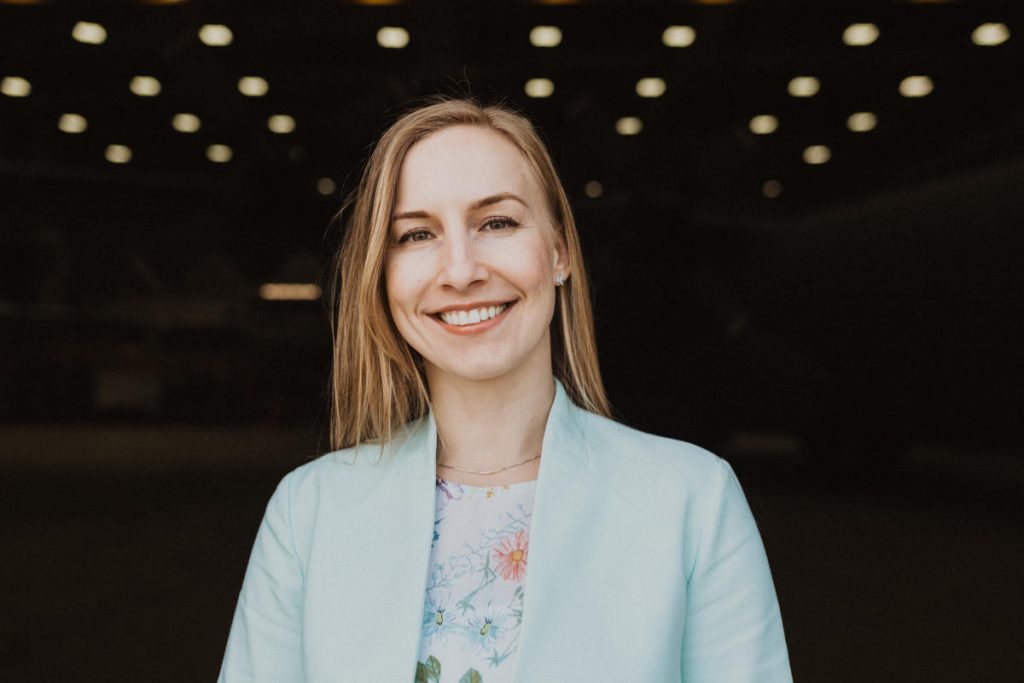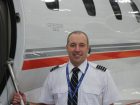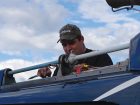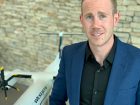
Features
Top 20 Under 40
Top 20 under 40, influencing the future of Canadian aviation
July 9, 2019 By Jon Robinson
 Olena Zagoskina, Senior Mechanical Engineer and TCCA Delegate, Cascade Aerospace.
Olena Zagoskina, Senior Mechanical Engineer and TCCA Delegate, Cascade Aerospace. In the annual Top 20 Under 40 program, sponsored by the Seneca School of Aviation, WINGS recognizes inspiring young leaders influencing the direction of Canadian aviation and aerospace. Presented here alphabetically, these leaders, who are all under the age of 40, were initially put forward through a nomination process lasting over several months. WINGS then determined the 20 honourees based on their demonstration of leadership, innovation, influence, achievement and/or dedication shown to their organization and the Canadian aviation industry.
Brant Arnold-Smith
Director, Security and Terminal Operations, Victoria Airport Authority
Victoria, BC
Brant Arnold-Smith, age 37, is the youngest member of Victoria Airport Authority’s executive team. He has been directly involved in aviation for just nine years, after focusing the early part of his career in emergency services, begining as a volunteer firefighter in his home town of Victoria. Arnold-Smith moved to the mainland to serve as an on-call firefighter with Surrey Fire Service and shortly after found his first opportunity to work in aviation when Vancouver International Airport (YVR) put out a competition for its Aircraft Rescue Team. The airport decided to move these services inhouse and Arnold-Smith was one of 24 successful applicants, among some 3,000, to join the team.
His role expanded as an airfield operations specialist, but he decided to leave YVR to join the Vancouver Police Department, where he served as a constable and sergeant for nine years. He was then approached to oversee YVR’s aviation security program. “It really helped with relationships at the airport with CBSA, U.S. customs, RCMP, CSIS… I walked a mile in their shoes as a police officer, so you have that instant connection and credibility,” he explains.
Eventually, Arnold-Smith’s responsibilities at YVR grew to include the Integrated Operations Centre/Emergency Operations Centre, where he was the primary management representative responsible for safety, security and efficiency of all airport facilities and operations (terminal, airside and groundside); in addition to managing all aircraft and airport emergencies. This came in the midst of incredible growth for Canada’s second largest airport, which is now approaching 27 million passengers per year – from a mark of around 17 million passengers in 2003 when Arnold-Smith worked on the Aircraft Rescue Team.
In late 2018, Arnold-Smith returned home to join Victoria International Airport (YYJ), which is also experiencing exponential growth, reaching above two million passengers last year (December 2018) – 5.9 per cent growth year over year. At YYJ, Arnold-Smith is responsible for aviation/corporate security, terminal/airport operations, regulatory compliance, emergency management and project management. “You never know what is going to get thrown at you in an airport and that is the beautiful thing of working in operations. It is a very dynamic and challenging environment – every day is different,” he explains. “Safety and security is the core of the aviation business. It is what passengers and employees expect. It is the cornerstone of what we do.”
A January 2018 economic impact study by InterVISTAS Consulting, shows YYJ generated 4,200 full-time equivalent jobs, $270 million in wages and $880 million in total economic output; amid an investment of $189 million into the airport since transferring to a local airport authority in mid-1997. Currently underway is a $19.4 million terminal building expansion. This 27-month project, that began in January of 2018, is the airport’s largest singular capital investment to date and the third phase of a multi-phase terminal and apron expansion.
“YYJ is one of the best airports in North America. We are the only one of two airports in Canada that have zero debt,” Arnold-Smith says, noting how much he has already learned joining the airport’s seasoned executive team. He also serves on the Canadian Airports Council Security Committee, Airports Council International Public Safety & Security Steering Group, BCAC Airports Committee, and BCAC Silverwings Awards Planning Committee.
Yannic Boily
Maintenance Manager, Premier Aviation Québec
Québec City, Québec
Yannic Boily, age 38, found his passion for aviation growing up near Jean Lesage International Airport (YQB). He graduated in 2003 from the National School of Aerotechnics in St-Hubert, Quebec, in aeronautical construction. He then began his career at C&D Aerospace Canada (Zodiac) as a programmer/operator of CNC machinery, focusiong on corporate aircraft interiors manufacturing.
Returning to Québec City in 2007, Boily became a licensed structural engineer, then team leader at Exceltech Aerospace and Discovery Air. During these years, he performed several major structural repairs on regional aircraft such the Bombardier CRJ, Dash-8 and Saab 340. “The structures side is more heavy work. When you do a preparation on the airplane, some people are stressed about it, but I really liked it,” he explains. “The bigger the repair was, the happier I was.”
In 2013, after less than two years as a structural supervisor, he progressed as a base maintenance manager overseeing maintenance, avionics, sheet metal and interior technicians, as well as painters. Having been in the field of aviation for 16 years, Boily quickly asserted himself as a key leader on the Premier Aviation Quebec team, which took over the Discover Air operation in 2016. He now leads a team of more than 100 people for Premier.
“We have a really nice core. We are experts on regional aircraft and I really like the culture of the company and the vision of the owner,” he says. Holding six lines, Premier aims to turn four lines per month, explains Boily, which equates to working on approximately 40 to 48 aircraft per year. Focusing on continual learning, Boily is pursuing a Certificate in Management at Laval University. “I’ve always liked to be a leader, a decision maker, to initiate change and make progress.”
Logan Brown
Business Development Lead, Innotech-Execaire Aviation Group
Toronto, ON
Logan Brown, age 34, grew up in the world of aviation with a father who recently retired after 30 years as an aircraft mechanic with Air Canada. Brown holds a breadth of aviation knowledge from taking on a range of roles early in his career. This includes being a certified AME and licensed pilot, but extends to his experience in aircraft design. During his time at Diamond Aircraft, Brown worked on helping to design modern avionics for the D-JET, which included handling power distribution and needed regulation requirements.
Brown then joined Air Canada and ultimately took on responsibilities for setting up all of its international stations for the 787 cabin design. “I spent four years in the airline industry and it is a different life style. I wanted to go back to what I love and that’s private aviation or general aviation,” he says. “Innotech-Execaire has such a vast share in the marketplace… I wanted see what I could do to grow the company.”
Brown for the first time took on a sales position, which in April 2018 turned into his current business development role. He has helped grow Innotech-Execaire Aviation’s third-party maintenance partnerships within the commercial airline sector, resulting in the hiring of 16 more mechanics across Canada to handle the new business.
Brown’s background in aircraft design has also helped the company in closing transactions around internationally imported aircraft. His extensive knowledge on regulations, requirements and certifications, helps him serve as a consultant for IEAG’s clients, which now includes managing approximately 50 aircraft.
Travis Burrows
Standards Captain, WestJet Encore
Calgary, AB
Travis Burrows, age 31, grew up in a small town and found his way into aviation from a neighbour who was building an airplane in his garage. Burrows took his first flight on that home-built plane down the Red Deer Valley toward the badlands of Drumheller. He now often takes aspiring pilots for discovery flights along the same route in his co-owned 1948 Cessna 170.
“I would never have been able to get into flying as a career if it wasn’t for people who took the extra time and put that into mentorship to be there for me,” Burrows says. “Part of it is paying it forward, but on the other side, it is just super important for the growth of our business to help out new people coming along.”
Burrows joined WestJet Encore five years ago as one of the regional airline’s first pilots. At the time, Burrows remembers WestJet Encore had five airplanes and it now has 47 and some 600 pilots, many of which he is in direct contact with as a Standards Captain, trainer, recruiter and ambassador for Encore – the fourth largest operator of the Bombardier Q400, now running regional routes across the country and into the U.S.
In addition to being on the WestJet Pilot Selection Team, Burrows is heavily involved in improving Encore’s flight procedures, which recently included a major project to implement RNP approaches to save huge amounts on fuel, among other operational efficiencies, as well as a new flight data monitoring program. “I get to work on some cool projects, which is amazing from a career standpoint. But at the end of day, I love being in the airplane, being proficient in the flight deck,” he says, “and I can’t see my life without that either.”
Jason Doell
Lead Hand, Chinook Aviation
Calgary, AB
Jason Doell, age 38, discovered his love for airframes during the three-year aeronautical engineering program at the Southern Alberta Institute of Technology. He then joined one of North America’s leading helicopter airframe repair specialists in Chinook Aviation and continued to learn about his airframe passion, obtaining his structures license, also from SAIT, in 2003.
Founded in 1986 by Helge Kirmse and located at the Springbank Airport in Calgary, Chinook is a Bell Authorized Customer Service Facility, holding certified airframe fixtures from the OEM and a 7,000-square-foot hanger built in 2002 to accommodate several medium-sized machines. “I’m like a pig in mud there, completely immersed in it. Everything about Helge’s hangar and his tooling is airframe. There is no deviation from that and I feel really blessed to be part of that team,” says Doell.
Doell has been the lead hand at Chinook for around 10 years, currently working with four fully equipped licensed technicians focusing on structural issues like parts fabrication, fuselage fixes, and mobile Maintenance Repair Parties. “No one can predict airframe problems and we are the company that fixes the serious ones,” Doell says, noting his need to travel at a moment’s notice is only be possible because of the support of his wife, Amber.
“I will go out to some far-flung base and be the hero, but there is a lot of support that goes unrecognized,” he says, also noting the importance of logistics organized by Chinook’s team back at home base, particularly when it comes to on-demand structural repairs that often relates to a grounded aircraft. “We are surrounded by enthusiastic airframe techs. It’s hands-on learning with a small shop, even with our high-water mark of 10 technicians.”
Doell also serves as treasurer with the Classic Aircraft Restoration Society, which is unique in its goal to make machines fly, which includes the group’s current de Havilland Chipmunk project.
Darryl Dowd
Vice President, Airport Operations, Winnipeg Airports Authority
Winnipeg, MB
Darryl Dowd, age 39, initially wanted to become a pilot, following in his grandfather’s footsteps who flew for Air Canada, but his direction changed on the morning of September 11, 2001, when he was sitting with his flight examiner watching the tragic events unfold in New York. Instead, Dowd has built a successful career in airport management and is now responsible for the on-going operation of James Armstrong Richardson International Airport (YWG), which welcomed approximately 4.5 million passengers in its most recent year. He has been with Winnipeg Airports Authority (WAA) for more than six years, after building a wealth of knowledge with the Greater Toronto Airport Authority.
When he first came to YWG, Dowd focused on revamping the airport’s integrated opertions centre. “I work here with a great team and we are able to put the right people in place to provide a good system for the day-to-day operations and incident management. Now we are starting to see the benefits of that to get much better data,” he explains. “We are using a product called IBM Maximo and we are really excited about what the next few years will bring with artificial intelligence and machine learning. We think we can get very predictive in the day-to-day factors that drive operations.”
WAA continues to invest in its airport campus, including ongoing construction of a $27 million Ground Services Equipment Building set to open this fall. In March 2019, YWG introduced Otto as the first autonomous airport snowplow in North America. The specially designed ATI Snow Mauler is about 30 per cent of they way there, explains Dowd, understanding this winter will be a critical testing point for its ability to remove snow from the airfield.
Laura Foote
Air Traffic Controller, NAV Canada; Operations and Branding, Elevate Aviation
Edmonton, AB
Laura Foote, age 34, served in the artillery branch of the Canadian Armed Forces for 13 years. After moving to Edmonton from the East Coast, she became instrumental in the development of Elevate Aviation, a non-profit designed to inspire youth to join the world of aviation, with an emphasis on mentoring young women. She took on many of the administrative roles during Elevate’s quick rise, including her work on grant proposals that secured approximately $700,000 in funding over the past two years.
“We now have a couple hundred women in the mentorship program. As of last year, we estimated that we have reached about 5,000 people [primarily through cross-country tours] in previous years; and this year alone we are probably going to double that,” Foote says. With its growth, Elevate is starting an ambassador program to develop provincial leadership. This will also help in the group’s goal to open more learning centres across the country, after starting up its first such centre at Edmonton International Airport earlier this year.
Foote also began training as an air traffic controller in 2015 and took her place in the Edmonton control tower focusing on high-artic routes. Foote is currently leading Elevate’s Status of Women Project, which involves the primary grant from the Federal government, as well as Elevate’s branding, Website and the annual fundraising gala.
Darrel Forest
Production Manager, CF34/CFM56 Business Unit, StandardAero
Winnipeg, MB
Darrel Forest, age 38, joined StandardAero as a technician 16 years ago, rising through the ranks to reach a leadership role within the company’s CFM56/CF34 business unit. He joined StandardAero Winnipeg as a repair and overhaul technician in 2003, initially working on the company’s Rolls-Royce T56 turboprop team. The focus of his four years working on the T56 was in the reduction gearbox cell, contributing to the high-quality MRO services delivered by StandardAero to military operators of the C-130 Hercules and P-3 Orion.
In 2007, Forest moved to StandardAero’s Plant 6 facility in Winnipeg, home to the company’s GE CF34 and CFM International CFM56 engine lines. He worked in various roles as a technician supporting the CF34 and CFM56 for eight years, the CFM56 line being introduced under a contract signed in June 2009. In 2014, Forest was recognized through StandardAero’s True Blue Award for being part of a four-person team to tackle a CFM56 Fuel Leak Reduction at Test project, thereby improving test cell first time pass-off rates.
Since 2015, Forest has served as production manager within the CF34/CFM56 business, which represents the highest value production line within the Airlines & Fleets sector, itself the largest of StandardAero’s four divisions. He oversees a team of 38 technicians. “StandardAero is a great family and the opportunity for growth is giant… A huge impact for me personally is watching my team become better.”
Forest is focused on problem-solving and continuous improvement through training, information sharing and mentoring. He lives by the same standards of continual learning and is currently studying for his Certificate in Management from the University of Manitoba, to add to his existing accreditations from Red River College and StandardAero.
Ginny Koseruba
Program Manager, Cascade Aerospace
Abbotsford, BC
Ginny Koseruba, age 38, found her passion for aviation through an uncle who was a career pilot. She has progressed rapidly through various roles at Cascade, where she began as an AME-E apprentice in 2004. Her technical knowledge and organizational skills soon resulted in a promotion into a maintenance planner role.
A graduate of the Lean Sensei Belt program, Koseruba then became a planning supervisor, helping to lead a diverse team focused on maximizing productivity in all of Cascade’s operations. She then received a promotion to her current role as program manager, overseeing all aspects of program delivery for key customers. She manages the third line maintenance in Abbotsford for Lockheed Martin supporting the CC-130J Super Hercules program for Canada. Also for Lockheed, she oversees a Contractor Maintenance Team and group of Field Service Representatives who provide support at CFB Trenton, as well as to deployed troops requiring technical support. Another key current program for Koseruba involves overseeing the Boeing 757 Large Display Screen speed line modification program for a large freight carrier, with 75 aircraft conversions to an upgraded cockpit configuration.
“I’m most grateful for the mentors, both personal and professional, I’ve had the opportunity to work with during my 15 years at Cascade,” says Koseruba, who is also the company’s leader for the Girls Fly Too event that takes place at Abbotsford Airport.
Connor Hart
Ground Operations Manager, WestJet
Calgary, AB
Connor Hart, age 27, was studying marketing at university and found his way into aviation through a family friend’s Facebook post about a ramp job at WestJet. After graduating, he continued with WestJet as a frontline ramp agent and quickly became a daily shift manager to take on more responsibilities with ground operations in Calgary. This included helping to oversee training and introducing new ground equipment for the airline’s towing team.
As operations manager, he is now a senior operational leader for WestJet’s hub airport with more than 150 flights per day. He liaises with the airport authority and external agencies, as well as internal safety and standards teams and follows up on incident and hazard reports. He is also heavily involved with leading continuous improvement for ground operations, including a new Auxiliary Power Unit (APU) fuel savings initiative, which adds another task to the staff – immediately plugging an arrived aircraft into the bridge, before accessing baggage, to turn off the APU.
His focus on continuous improvement is also steered toward training with the ground workforce of 700 people. “We were able to decrease our training budget by 20 per cent within the first three months of taking on that role, working with my training manager who was a huge help.” In addition to making better training products, Hart was also tasked with helping to oversee a new Widebody Performance Team, created to look after the full turn of WestJet’s new 787 Dreamliner aircraft, which is also a major focus of the new ground-operations training; and subsequently expanded Hart’s role beyond below-the-wing operations to above-the-wing customer service.
“My team takes a lot of pride in making sure the [787] is working well. Even if we take a one-minute delay it definitely does not sit well with my team. It is great to see people riled up about a really minor miss on something that might have been completely out of our control, but we do not get flustered – one aircraft at a time.”
Kevin Lawes
Chief Pilot, Vanguard Air Care
Winnipeg, MB
Kevin Lawes, age 33, grew up around aviation with his mother recently retiring from Transport Canada. His first aviation job, as he was going to university, was working in ground operations at Keewatin Air, where Lawes would eventually take his first flight line position running charters into the north. Six months later, by October 2011, he joined a medevac flight crew, initially to gain more hours, based out of Nunavut.
Lawes then joined Fast Air in mid-2014 and eventually became the Winnipeg operation’s chief pilot in the 703 sector, before serving for a short stint at Sky Regional Airlines operating out of Toronto. When he rejoined the Fast Air team in late-2017, Lawes brought a wealth of knowledge with him as both a turboprop and jet captain, with experience in 604, 703, 704 and 705 operations.
His return to Fast Air led to him becoming the chief pilot for the operation’s restructured Vanguard Air Care division, which now operates from four bases to primarily cover the needs of Manitobans, once again taking on the demanding role as a medevac pilot. “You never know when you are going so it can be difficult, but you are obviously maintaining a high level of safety,” Lawes explains. “You are dealing with potentially more adverse weather on a more frequent basis, while still ensuring you are following the rules and that you don’t allow the mission to take over your judgement. Even if you have an urge to go help that person, you have to make sure the safety of the crew is maintained.”
As chief pilot for Vanguard Air, he is responsible for 18 pilots, in addition to regular roles in flight training at Fast Air. One of the primary administrative functions in which Lawes excels centres around ensuring all company Minimum Equipment Lists are current and relevant to the Fast Air/Vanguard operations, which includes serving as a conduit to Transport Canada.
Sukhvir Mavi
Manager, Projects and Facilities Management, Nieuport Aviation Infrastructure Partners
Toronto, ON
Sukhvir Mavi, age 30, began his career in aviation by focusing on becoming a commercial pilot, which included finishing his flight training in Miami. He then went back to India to get his license there, before joining an airline in the Philippines for about five months. Mavi came to Canada in 2013 with the goal of becoming a flight instructor in Ottawa, but instead joined the Georgian College Aviation Management program, which ultimately led to jobs with Air Georgian and then Air Canada as a SOC duty manager.
Around two years ago, Mavi joined Nieuport Aviation, which owns and operates the passenger terminal at the Billy Bishop Toronto City Airport, helping to enhance customer service for the airport’s 2.8 million passengers. The airport accounts for more than $2.1 billion in economic output each year and supporting 6,500 jobs, including 1,960 associated directly with airport operations. Over the last four years, Nieuport has invested more than $50 million in the airport, including the recently completed terminal upgrade.
“We completed the project within two years time, under the date that was promised, so it feels great part of the project itself,” Mavi says. He started with Nieuport in a project coordinator role, serving more on the construction-team side of the terminal upgrade project. This involved leveraging his aviation background to establish a milestone schedule for the operations team and other stakeholders. Based on his performance, however, Mavi last year was promoted into a project manager position to help oversee the completion of the terminal upgrade.
“I have a long-term goal to become the CEO of an airline,” Mavi says. “I would definitely have the opportunity to work internationally and use a zig-zag pattern to get to my goal… and it is imperative to take on different kinds of roles and build my experience.”
Keith McCormack
Manager, Global Partnerships, Air Canada
Mississauga, ON
Keith McCormack, age 31, received his Bachelor’s degree in Commercial Aviation Management at Western University, which allowed him to experience the global aviation industry by participating in international studies at the European Business School near Frankfurt, Germany. His career began in 2011 with Lufthansa before joining Air Canada’s growing cargo sector, where he has held multiple positions over the past six years.
His current role is to manage Air Canada’s top cargo customers, engaging with the world’s largest logistics companies to ensure Air Canada is a top-of-mind partner. “Cargo is a company within company. You get to touch all of the departments that you find in the airlines, such as revenue management, sales, finance and operations,” he says, noting this structure helps him ensure Canadian products can access world markets.
In 2018, McCormick participated in a trade mission to Shanghai to improve product knowledge of Canadian seafood in China. Air Canada ships about 40,000 kilograms of freight per day to China. “We have gone into business with a company in China that is an e-commerce platform, which is quite advanced,” he explains, focusing on Canadian lobster. Customers in China can now order lobster online, as it gets packed in Halifax and moves onto Air Canada to the destination. “From there it is sent out to market by this e-commerce company and it is delivered to the door of the person who orders it.”
McCormick recently received the Award of Excellence from Air Canada and in 2018 completed his Masters at Embry Riddle Aeronautical University. He is also a licenced commercial pilot and flies small aircraft in his spare time.
Anthony Norejko
President and CEO, Canadian Business Aviation Association
Ottawa, ON
Anthony Norejko, age 39, took on the leadership of the Canadian Business Aviation Association in August 2018, four years after he joining the organization’s board to focus on strengthening the association’s membership, which currently includes some 400 members located across the country. He also played a pivotal role in working with the Greater Toronto Airport Authority on slot restrictions, helping to establish the CBAA/GTAA Technical Working Group.
Norejko provides a strong blend of aviation and strategic planning knowledge. His leadership in business aviation largely began when he served as director of aviation and chief pilot for Walmart Canada; and later as the principle of his own aviation-service company, CrewSked. Norejko then left aviation to hone his financial and strategic planning skills as vice president, strategy and operations, north, at FirstService Residential.
As president and CEO of the CBAA, Norejko is injecting a new mandate to promote and simplify business aviation. “The association needs to play a role foundationally in the public perception about the use of business aviation… it is a tool that a business uses to conduct its work,” he says, describing the promotional side of his mandate and noting there are approximately 250 operators in the sector providing positive economic impact.
“Simplifying business aviation sounds simple, but when you think about the amount of complexity and the busy lives of our chief pilots and directors of flight operations… how can we make the lives of our operators easier,” continues Norejko. “I know from firsthand account what it is like to manage Safety Management Systems, to take best practices and promote good ideas.”
Tyler Perin
Manager, Hub Operations, Air Canada
Mississauga, ON
Tyler Perin, age 28, received an introductory flight out of Kingston Airport as a high-school graduation gift and realized his passion for aviation within minutes of lifting off the ground. He attended Algonquin College’s relatively new aviation management program at the time, and earned a multi-engine rating to fly floats and a commercial pilot’s licence. He moved to Yellowknife for a job with Air Tindi, hoping to get on its flight line, and eventually took a second job with Strategic Aviation, where he would come to manage ground operations.
In 2012, Perin then moved back to Ontario for a job with Air Canada’s cargo operation, where he would quickly rise through three positions to help manage the company’s largest and busiest hub. Approximately one million kilograms of cargo moves through the hub on a daily basis, 1.3 to 1.5 million during peak periods. Ultimately, Perin and his team of 10 managers are responsible for the safe and swift movement of this cargo.
“I love the challenges of being the hub, being the centre of attention, managing the largest cargo operation in Canada,” Perin says, noting the cargo operation’s main facility is 265,000 square feet in addition to a recently acquired second facility of 60,000 square feet to accommodate growth. “Last year, Air Canada grew the second fastest out of any cargo belly carrier in the world – second only to Turkish.”
Perin continues to explain the growth is related to Air Canada bringing on new planes with more capacity and fuel efficiency, including the 787 Dreamliner, which are ideal for the routes they fly along key trade routes into the U.S., Europe and as far as China. To put the impact of air cargo into perspective, Perin explains, “Although only two per cent of the world’s global trade travels by air, that two per cent represents 40 per cent of the value of global trade.”
Allison Rumbolt
S92 Pilot, Cougar Helicopters
St. John’s, NFLD
Allison Rumbolt, age 29, grew up in Mary’s Habour, a town of around 400 people in southern Labrador where aviation served as a regular means of transportation for the isolated community. Her mother worked part time for the local airline, Air Labrador, and her father took a position with the provincial government as the operator of the Mary’s Habour airport. From a young age, Rumbolt regularly met pilots and she remembers a particular helicopter flight, arranged by her father when she was about 10 years old, along a popular salmon-fishing river. She became hooked on the dream of becoming a helicopter pilot.
Before graduating high school, with her passion for aviation well-known in the community, Rumbolt was approached to become a junior dispatcher for Canadian Helicopters in Goose Bay, as she prepared to attend flight school that summer. She eventually began flying AStars at age 18 for Canadian Helicopters.
She has now been with Cougar Helicopters for five years and has amassed 3,700 flight hours. Rumbolt is first officer on the operation’s heavy S92 helicopter, flying to fulfill Cougar’s contracts with oil-and-gas companies operating offshore in Newfoundland. “Our biggest challenge in Newfoundland is the weather. It is always changing,” she says. “You will get an 1/8th of a mile of fog and 120 kilometer per hour winds. I like the challenge that every day is something different, even if we might go to the same rigs.”
Rumbolt explains she cannot wait to get back into the helicopter after a rest period, which, as a member of COPA flight 97 and Whirly Girls, a mentor with Elevate Aviation, as well as volunteering for the local minor hockey association, is often filled with giving back to the communities that provided her with so much opportunity. “One of the things I am most proud of is flying into my home town of Mary’s Harbour, landing, and going home to have dinner with my parents.”
Toby Spitzer
Aircraft Maintenance Engineer and Pilot, Slave Lake Helicopters
Slave Lake, AB
Toby Spitzer, age 39, grew up in Squamish, BC, where he discovered a passion to both fly and fix helicopters. He took his first solo flight at age 16 and had his private fixed-wing license at age 17. Two years later, he acquired his commercial rotary-wing license, but his true passion was still focused on engineering. “I always wanted to be a pilot-engineer. That way I can take care of my own machine,” he says. “The ability see this piece of technology fly, and make it do what it can, to be a part of that is great.”
Spitzer attended the British Columbia Institute of Technology on his way to gaining an AME license in 2005 at the age of 24. In 2011, he joined Slave Lake Helicopters where he focuses on rotary-wing aircraft repairs and heavy maintenance, as the operation’s lead hand. His willingness to tackle and trouble-shoot issues and his out-of-the box, creative ways to strategize, have made him an indispensable asset to the everyday operations at Slave Lake, which primarily focuses on the forestry industry, as well as holding contracts with a prime electrical company in the region.
Spitzer still flies from time to time, particularly if the operation, which runs seven modern helicopters (two B3s, three B2s, a 120, and a 206), is short a pilot. Slave Lake has five technicians and Spitzer enjoys passing on his engineering knowledge to the younger generation. “You are treated like family here, with a small group of people who get along well together,” Spitzer explains.
Jessalyn Teed
First Officer, Sunwing Airlines
Mississauga, ON
Jessalyn Teed, age 24, found her passion for aviation at age eight when her parents saw an ad in a newspaper and took her to a kids-can-fly event at Muskoka Airport. She was the last person to go up, getting an extra-long ride, and was so mesmerized by the experience that she set her mind toward becoming a pilot. In 2017, she graduated from the University of Waterloo, Geography and Aviation BES, completing a four-year degree in three years, while also volunteering for the aviation program. This set Teed on an early path of mentorship for her peers.
“I was a little intimidated by that at first, because I am young. Was I ready to give back – do I have that knowledge? I do not think it is necessarily about that. I want to be a resource,” she says. “My path is so relevant to students graduating today… The industry has very much accelerated in the past few years, so it is important for me to be able to share my experiences with them.”
Teed has been working with a Sunwing colleague and the Waterloo Wellington Flight Centre to develop a course focusing on multi-crew environments. Set to launch this summer, Teed explains the course topic is becoming critical for younger pilots, who are finding more career opportunities with airlines. This summer will also see the launch of a Sunwing Mentorship Program that Teed has developed to pair up experienced Sunwing pilots with new pilots.
Still, Teed who crews the 737-8 is focused on the pure enjoyment of flying. “When I do the walk-around and I’m at the tail of that aircraft and I look up – ‘Oh my goodness, I just landed this thing.’ And it may have been into a very mountainous terrain area with a short runway, and bad weather. Looking back five years, [when I was] landing a little Cessna 152 in a cross wind and struggling with that, to see where I am today is just fantastic.”
Peter Wheatley
Director of Sales Operations, Airlines & Fleets, StandardAero
Winnipeg, MB
Peter Wheatley, age 34, has 15 years of experience in the aerospace MRO industry, having initially joined StandardAero’s Winnipeg team as a summer intern in 2004 while studying for his BSc in Mechanical Engineering at the University of Manitoba. He graduated in 2007, after completing the five-year program one year early.
Upon graduating, Wheatley joined StandardAero full time as a production engineer, participating in numerous high-visibility projects, including a redesign of the method for tracking rework components using capacity modeling. Two years later, he accepted a role as quality manager, providing strategic direction for the quality function within the Turboprops and Fleets (TPAF) team, which he happened to name. In 2011, he was appointed as a senior service engineer within the TPAF Service Centre function. In this role, Wheatley mentored five engineering employees within the Service & Production Engineering group, and facilitated the Training Development Plan process for the TPAF Engineering function.
Two years later, Wheatley was promoted to the role of service engineering manager within the TPAF group, leading 12 direct reports. Here, he successfully led the PT6A-68 First Article Inspection process, and helped increase the TPAF team’s First Test Pass Rate to historical highs. Wheatley also completed his MBA at the University of Manitoba while in this role.
In 2018, Wheatley was appointed as director of sales operations for StandardAero’s $2 billion Airlines & Fleets team, managing the global sales and operations planning process for the division’s transactional sales team and serving on the division’s sales leadership team. He has spearheaded a revamp of the team’s Salesforce CRM system, focused on accurate dashboarding and induction planning.
“Through each of my different roles, I found a way to drive change and improvement within that area and I think that would be what I am most proud about in my career,” Wheatley explains. In June, he was also appointed chair of the University of Manitoba Alumni Association.
Olena Zagoskina
Senior Mechanical Engineer and TCCA Delegate, Cascade Aerospace
Abbotsford, BC
Olena Zagoskina, age 32, found a passion for aviation at an early age with her father being an aerospace engineer. They both attended the National Aerospace University in Kharkiv, Ukraine. She joined Cascade Aerospace in 2011 and quickly reached her current role by looking after the development and certification of system-related aspects for highly complex modification programs. Working on a variety of projects, she was a leader in the very challenging, five-year conversion of a Bombardier Q400 to multi-mission role. The modification added large auxiliary fuel tanks essentially doubling the aircraft’s mission time.
As a technical lead for fuel tank safety, she was responsible for meeting aviation safety needs in case of a lightning strike, electrostatic discharge, and other ignition sources. This included the responsibility to develop subject matter expertise in the design and certification of fuel systems and leading the highly complex developmental and certification of ground and flight tests.
Zagoskina’s technical skills and ability to interact at a peer level with senior and experienced individuals have led Cascade to have her represent the company on industry and regulatory committees. She was a member on the FAA Aviation Rulemaking Advisory Committee, developing recommendations for new regulations to enhance aircraft safety in case of emergency landings. She is also a Cascade representative on the Aerospace Industries Association of Canada’s Civil Aviation Committee.
Zagoskina is also currently leading the system safety aspect for a major avionics upgrade on CL 215/415 aircraft used for fighting fires. This is another complex program for Cascade Aerospace beginning from concept development.
In early 2019, Zagoskina was authorized by Transport Canada as one of its youngest ever Delegate Engineers. “When I was granted delegation by Transport Canada it was validation that all of my hard work paid off; and that they believe I am strong enough to actually have the privilege to approve design,” says Zagoskina, who became a Canadian citizen four years ago. | W



















